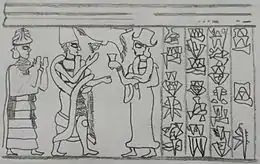Abba-El I
Abba-El I (reigned c. 1750 BC – c. 1720 BC - Middle chronology) was the king of Yamhad (Halab), succeeding his father Hammurabi I.[1]
| Abba-El I | |
|---|---|
| Great King of Yamhad | |
 | |
| Reign | c. 1750 BC – c. 1720 BC, Middle chronology |
| Predecessor | Hammurabi I |
| Successor | Yarim-Lim II |
Reign
Hammurabi I left Yamhad a prosperous country, and Abba-El's reign was relatively peaceful. He maintained good commercial relations with Babylon.[2] The main event of his reign was the rebellion of Zitraddu, governor of the city Irridu which belonged along with its district to Abba-El's brother Yarim-Lim
A tablet discovered at Alalakh explains the circumstances which led to the forming of the kingdom of Alalakh; it revealed that Abba-El destroyed Irridu and compensated his brother by giving him Alalakh as a hereditary kingdom for his dynasty under the suzerainty of Aleppo but that it should be forfeited if Yarim-Lim or his descendants committed treason against Yamhad.
Abba-El took an oath upon himself not to confiscate his brother's new kingdom and that he might be cursed if he ever did.[3] In return Yarim-Lim took an oath of loyalty to his brother, specifying that if he or his descendants ever committed treason or spilled Abba-El's secrets to another king, their lands would be forfeited.[4]
The Hurrians's influence seems clear during Abba-El's reign, as he recalls the help given to him by the Hurrian Goddess Hebat.[5]
Death and Ancestors
Abba-El died in ca. 1720 BC and was succeeded by Yarim-Lim II, who most probably was his son; however, Moshe Weinfeld believes that Yarim-Lim II was the same as Yarim-Lim of Alalakh.[6]
| Ancestors of Abba-El I | ||||||||||||||||||||||||||||||||||||||||||||||||||||||||||||||||||||||||||||||||||||||||||||||||||||||||||||||||||||||||||||||||||||||||||||||||||||||||||||
|---|---|---|---|---|---|---|---|---|---|---|---|---|---|---|---|---|---|---|---|---|---|---|---|---|---|---|---|---|---|---|---|---|---|---|---|---|---|---|---|---|---|---|---|---|---|---|---|---|---|---|---|---|---|---|---|---|---|---|---|---|---|---|---|---|---|---|---|---|---|---|---|---|---|---|---|---|---|---|---|---|---|---|---|---|---|---|---|---|---|---|---|---|---|---|---|---|---|---|---|---|---|---|---|---|---|---|---|---|---|---|---|---|---|---|---|---|---|---|---|---|---|---|---|---|---|---|---|---|---|---|---|---|---|---|---|---|---|---|---|---|---|---|---|---|---|---|---|---|---|---|---|---|---|---|---|---|
| ||||||||||||||||||||||||||||||||||||||||||||||||||||||||||||||||||||||||||||||||||||||||||||||||||||||||||||||||||||||||||||||||||||||||||||||||||||||||||||
References
Citations
- Beatrice Teissier. Egyptian Iconography on Syro-Palestinian Cylinder Seals of the Middle Bronze Age. p. 27.
- William J. Hamblin. Warfare in the Ancient Near East to 1600 BC. p. 259.
- Nadav Naʼaman. Canaan in the Second Millennium B.C.E. p. 285.
- William J. Hamblin. Warfare in the Ancient Near East to 1600 BC. p. 264.
- Iorwerth Eiddon Stephen Edwards. The Cambridge Ancient History. p. 41.
- Jimmy Jack McBee Roberts. The Bible and the Ancient Near East: Collected Essays. p. 150.